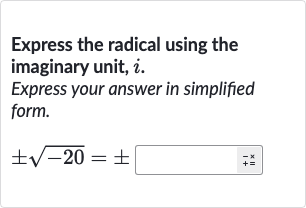Full solution
Q. Express the radical using the imaginary unit, .Express your answer in simplified form.
- Rephrasing and recognizing: First, let's rephrase the "Express the radical using the imaginary unit, , and simplify the expression ."
- Separating the square root: Recognize that the square root of a negative number involves the imaginary unit , where . We can express as .
- Replacing with : Separate the square root of the product into the product of square roots, knowing that . This gives us .
- Simplifying : Replace with , since they are equivalent. This transforms the expression into .
- Taking the square root of : Simplify by factoring it into , since is a perfect square and its square root can be easily calculated.
- Combining constants outside the radical: Take the square root of , which is , and bring it outside the radical. This leaves us with .
- Combining constants outside the radical: Take the square root of , which is , and bring it outside the radical. This leaves us with .Combine the constants outside the radical to simplify the expression. This results in .
More problems from Introduction to complex numbers
QuestionGet tutor help
QuestionGet tutor help

